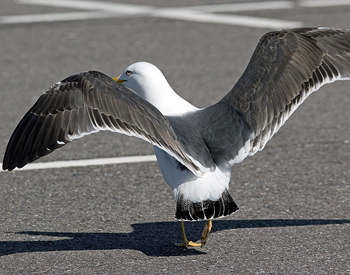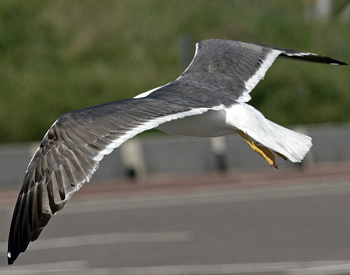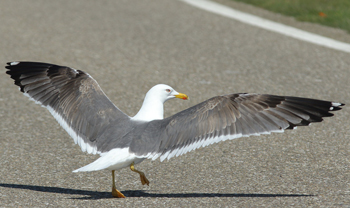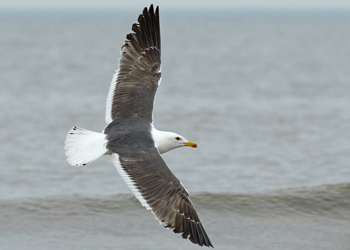 Lesser Black-backed Gull (graellsii & intermedius)
Lesser Black-backed Gull (graellsii & intermedius)
(last update:
lbbg 1cy May
lbbg 1cy June
lbbg 1cy July
lbbg 1cy August
lbbg 1cy September
lbbg 1cy October
lbbg 1cy November
lbbg 1cy December
lbbg 2cy January
lbbg 2cy February
lbbg 2cy March
lbbg 2cy April
lbbg 2cy May
lbbg 2cy June
lbbg 2cy July
lbbg 2cy August
lbbg 2cy September
lbbg 2cy October
lbbg 2cy November
lbbg 2cy December
lbbg 3cy January
lbbg 3cy February
lbbg 3cy March
lbbg 3cy April
lbbg 3cy May
lbbg 3cy June
lbbg 3cy July
lbbg 3cy August
lbbg 3cy September
lbbg 3cy October
lbbg 3cy November
lbbg 3cy December
lbbg sub-ad January
lbbg sub-ad February
lbbg sub-ad March
lbbg sub-ad April
lbbg sub-ad May
lbbg sub-ad June
lbbg sub-ad July
lbbg sub-ad August
lbbg sub-ad Sept
lbbg sub-ad Oct
lbbg sub-ad Nov
lbbg sub-ad Dec
lbbg adult January
lbbg adult February
lbbg adult March
lbbg adult April
lbbg adult May
lbbg adult June
lbbg adult July
lbbg adult August
lbbg adult September
lbbg adult October
lbbg adult November
lbbg adult December
sub-adult (4cy / 5cy): May

Lesser Black-backed Gull sub-adult, May 09 2014, Katwijk, the Netherlands. Classic graellsii type bird. Adut-like flight feathers but still with many immature patterned feathers.
General description
Normally, 5cy in May are extremely hard to separate from adults and the overlap in characteristics is severe. Probably, the only certain clue can be found in ringed birds. Furthermore, 4cy & 5cy LBBG's can be found in colonies, in full May courtship and raising chicks in August; clearly they participate in the the ordinary mating cyclus as adults do. By May, 4cy birds from graellsii populations can be distinguished from adults quite easily (see e.g. image 1 and image 2 and the ringed birds E056 E here and E104 E here) by e.g.:
- extensive black on the bill, but black may be lacking
- pale blue-yellow or white-yellow iris, but may be clear yellow as well
- pale yellow legs in some birds
- extensive streaking on the head in some birds
- many brown-grey coverts, often in the central greater coverts
- relatively small mirror on P10, often lacking a mirror on P9
- relatively small white tips on the primaries
- vermiculate feathers along the trailing edge.
We stress that these features seem to apply on a more extensive scale in graellsii than they do occur in intermedius, which in 4cy may be surprising reminiscent of adults.
Larus argentatus argenteus & Larus fuscus graellsii - Moerdijk, the Netherlands
Black on Greater Primary Coverts as indication for sub-adultness.
Overall, 8% (21 birds) of breeding Herring Gulls showed black on the primary coverts. Black was more frequent in males than females (males 12% (n = 146); females 3% (n = 128); Pearson χ2=6,99; P=0,008; df=1). This difference may be due to an age-sex interaction with respect to colonisation, as males return to the colony to occupy territories at younger age than females (Vercruijsse, 1999). For birds of known age (n = 33), the presence of black on the primary coverts is age-related in Herring Gull (b = -1.393, r2 = 0.408, P = 0.014; df = 1; table 2).
The majority (76%) of breeding Lesser Black-backed Gulls showed black on the primary coverts (n = 962) and we found no marked difference between the sexes (males 78% (n = 434); females 74% (n = 496); Pearson χ2 = 2,622; P = 0,105; df = 1). Our data of known-age Lesser Black-backed Gull (n = 76) suggest that both the number of primaries showing black (b=-0.071, r2=0.072, P=0.020) and the presence of black on the primary coverts (b=-0.189, r2=0.046, P=0.068) are age-related (table 2).
We scored 54 adult birds of known age in 6cy-14cy. 41 birds (75%), in all nine age-classes, were found showing neatly demarcated black pigmentation. 62 breeding LBBG in our sample are considered to be ‘sub-adult birds’ showing primary coverts with extensive black markings, pale brown tips and diffuse borders. 666 birds show limited black markings which are neatly demarcated; we consider such birds to be ‘mature adults’ (see plate 3).

Plate 3. Two example primary covert patterns to illustrate the division between ‘sub-adult’ and ‘adult’ Lesser Black-backed Gulls in our analysis. Left: the greater primary coverts in sub-adult LBBG oHZ show extensive dark centres and diffuse borders. Also note the dark centres on the secondaries and brown-black P9 and P10. Right: LBBG yET with neatly demarcated black markings, which are considered to be still possible in ‘adult’ birds. In fact, LBBG yET was ringed as pullus in June 1995, and now in its 12th calendar year.
| . | LBBG |
HG |
||||
| Age | No |
Yes |
n: |
No |
Yes |
n: |
| 4 cy | . |
100 |
13 |
. |
100 |
2 |
| 5 cy | 14 |
86 |
8 |
40 |
60 |
5 |
| 6 cy | 20 |
80 |
5 |
67 |
33 |
3 |
| 7 cy | 17 |
83 |
7 |
80 |
20 |
5 |
| 8 cy | 8 |
92 |
14 |
100 |
. |
5 |
| 9 cy | 50 |
50 |
4 |
100 |
. |
3 |
| 10 cy | 57 |
43 |
7 |
100 |
. |
1 |
| 11 cy | 50 |
50 |
6 |
100 |
. |
3 |
| 12 cy | . |
100 |
5 |
. |
. |
. |
| 13 cy | 33 |
67 |
3 |
100 |
. |
1 |
| 14+ cy | . |
100 |
3 |
100 |
. |
5 |
| Whole sample | 25 |
75 |
962 |
92 |
8 |
286 |
Table 2: Black pigmentation on primary coverts in known-age Herring and Lesser Black-backed Gulls (retrapped birds excluded). Values are % for their own age-class. Age in calendar years (CY).
We have illustrated all greater primary wing coverts of known-age Lesser Black-backed Gulls HERE.
Arrested moult in spring in sub-adult LBBG
In spring, it's not uncommon to find LBBG
with arrested moult in the primaries in the Netherlands. We do not believe
these birds to origin from nominate fuscus colonies, but rather are
representatives of both graellsii and intermedius. It is
known that nominate fuscus show arrested moult on a very regular
basis in spring (see the fuscus sections), but the birds we encounter in NW Europe show all
features commonly found in either graellsii or intermedius.
We therefore believe that arrested moult is an uncommon but regular
phenomenon in the taxa graellsii and intermedius.
Images of LBBG showing arrested moult in spring (!) can be found on these
pages:
- 3cy in April: image 0283, an individual in a Dutch colony
- 3cy in May: 4 images in the 3cy May section, probably intermedius
- 3cy in June: image of an intermedius
- 3cy in July: a fuscus candidate and a Dutch graellsii
- sub-ad in April: image 0584, a ringed intermedius
- sub-ad in June: Dutch graellsii with suspended moult
In most of these birds, the inner
primaries look very fresh, without extensive wear in the tips and
regarding wear, the outer primaries do not substantially differ what can
be found in other birds of similar age-classes. It therefore is believed
that most birds follow the common pattern of replacement in the complete
moult: i.e. all primaries are moulted between May - November. The inner
primaries then are replaced once again on the wintering grounds, somewhere
between January and April.
The intermedius bird at the bottom of this page is illustrative for this: it is
still growing P8, so moult has not been finished yet at the time it
already migrated north again. The black-ringed T7PF proofs arrested moult also occurs in British LBBG.

Lesser Black-backed Gull sub-adult, May 09 2014, Katwijk, the Netherlands. Classic graellsii type bird. Adut-like flight feathers but still with many immature patterned feathers.
LBBG colonization of Belgium
The Belgian magazine Oriolus published a special edition on gulls, which we here summary, supplied with
extra data from the Netherlands. The very informative articles of Oriolus
give excellent insight in the development of gull colonies, illustrated
with many pictures, tables and charts and is highly recommended read stuff
for all interested in gulls.
"The Herring Gull Larus argentatus and Lesser Black-backed
Gull Larus fuscus as breeding birds in Flanders, Belgium",
by Eric Stienen, Jeroen van Waeyenberge & Harry Vercruijsse, published
in Natuur.Oriolus 68(3), July-September 2002, p 104-110.
IntroductionLBbG (L. fuscus) only started breeding in Belgium in the mid 80's, with dramatically increasing numbers in two decades, from one pair in 1985 to 2863 pairs in 2001. Colonization started at the coastal nature reserve "Het Zwin" at Knokke, but numbers never exceeded 40 pairs here. Rapid development LBbG numbers came from the reclaimed industrial harbour area of Zeebrugge from 1987 onwards with 2695 pairs in 2001. Other colonies can be found at the inner harbour of Zeebrugge and roof top breeders at Oostende, south along the Belgian coastline (only 8 pairs in 2001). Counting methodPrior to hatching all nests in the harbour of Zeebrugge were counted annually. From a high watching point, the proportion numbers of nesting LBbG's compared to Herring Gulls were estimated. Next step was counting all nests, without discern of species, marking them with a small match stick and discount the proportional ratio afterwards. For lacking annual values, numbers of adjacent years have been used to estimate the annual number, considering the long-term trends and development of locations within the colony concerned.
ResultsLBbG only recently settled as breeding species in Belgium and all colonies were occupied after Herring Gulls settled for several years earlier. However, number of Herring Gulls have been low over the first years, sometimes zero over longer periods in the 1960's, and it's only from the mid 1990's, with the expansion of the industrial area of Zeebrugge (especially the Outer harbour of Zeebrugge) that counts exceeded 100's. Outer harbour of Zeebrugge is the only place where numbers of LBbG exceed Herring Gull numbers, now holding over 94% of the Belgian population. The explosive expansion at the Zeebrugge harbour was followed by expansion further south, at Oostende LBbG started breeding on roof tops, as Herring Gulls already had been doing from 1993 onwards, but numbers remain low. During the period of 1992-2001, LBbG numbers almost doubled with an average increase of 99,3%. An estimated 1,8% of all European LBbG's can be found in Belgium. DiscussionThe rapid expansion in Belgian
colonies must be set in an international perspective. LBbG have
expanded dramatically over the last decades in NW Europe, now
breeding as far south as the Ebro Delta in Spain. In the
Netherlands, numbers of breeding LBbG have been growing strongly
over the years 1960-2000, now breeding in vast colonies along the
coast and inland industrial complexes and on roof tops.
There have been two "grow waves": by protection rules
early in the century and another by the increase in food supply
from the 1960's (fishery, agriculture and landfills). Now many
landfills in the Dutch Delta close, there is a strong decrease in
numbers of breeding Herring Gulls at e.g. Saefinghe (Westerschelde),
with numbers dropping from over 8.000 to just 1.000. LBbG is an opportunistic
species, exploiting these new food supplies and using new human
habitats (reclaimed areas and roof tops). futureGiven these good breeding
results, one may expect to find an ongoing strong increase at
Zeebrugge. The LBbG growth rate for 2001 was an astonishing 126%.
For sure, the next years will show increasing numbers of breeding
LBbG as well. Further inland dispersion and settlements on roof
tops can be expected as well, as is already a trend in surrounding
countries. |
||||||||||||||||||||||||||||||||||||||||||||||||||||||||||||||||||||||||||||||||||||||||||||||||||||||||||||||||||||||||
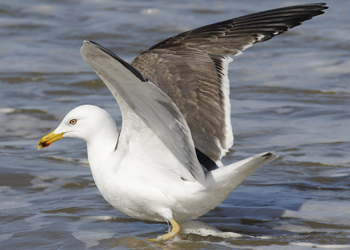 |
 Lesser Black-backed Gull graellsii T7PF 4CY, Boulogne/Mer, NW
France,
May 01 2003.
Lesser Black-backed Gull graellsii T7PF 4CY, Boulogne/Mer, NW
France,
May 01 2003. Arrested moult at P6.
 Lesser Black-backed Gull graellsii 020A 4CY-5CY, May 2012 & April 2013, Calais, NW France. Picture: Jean-Michel Sauvage.
Lesser Black-backed Gull graellsii 020A 4CY-5CY, May 2012 & April 2013, Calais, NW France. Picture: Jean-Michel Sauvage. Lesser Black-backed Gull graellsii 362K 4CY, May 19 2011, Calais, NW France. Picture: Jean-Michel Sauvage.
Lesser Black-backed Gull graellsii 362K 4CY, May 19 2011, Calais, NW France. Picture: Jean-Michel Sauvage. Lesser Black-backed Gull graellsii 963N 4CY-5CY, May 2011 & April 2012, Calais, NW France. Picture: Jean-Michel Sauvage.
Lesser Black-backed Gull graellsii 963N 4CY-5CY, May 2011 & April 2012, Calais, NW France. Picture: Jean-Michel Sauvage. Lesser Black-backed Gull graellsii ACAJ 5CY, May 29 2003, Voorhaven, Zeebrugge, Belgium (51.59N,04.02E). Ringed at Zeebrugge as pullus.
Lesser Black-backed Gull graellsii ACAJ 5CY, May 29 2003, Voorhaven, Zeebrugge, Belgium (51.59N,04.02E). Ringed at Zeebrugge as pullus. Lesser Black-backed Gull graellsii ADAF 5CY, May 29 2003, Voorhaven, Zeebrugge, Belgium (51.59N,04.02E). Ringed at Zeebrugge as pullus.
Lesser Black-backed Gull graellsii ADAF 5CY, May 29 2003, Voorhaven, Zeebrugge, Belgium (51.59N,04.02E). Ringed at Zeebrugge as pullus. Lesser Black-backed Gull graellsii AHAS 5CY, May 29 2003, Voorhaven, Zeebrugge, Belgium (51.59N,04.02E). Ringed at Zeebrugge as pullus.
Lesser Black-backed Gull graellsii AHAS 5CY, May 29 2003, Voorhaven, Zeebrugge, Belgium (51.59N,04.02E). Ringed at Zeebrugge as pullus. Lesser Black-backed Gull graellsii AMAK 5CY, May 29 2003, Voorhaven, Zeebrugge, Belgium (51.59N,04.02E). Ringed at Zeebrugge as pullus.
Lesser Black-backed Gull graellsii AMAK 5CY, May 29 2003, Voorhaven, Zeebrugge, Belgium (51.59N,04.02E). Ringed at Zeebrugge as pullus. Lesser Black-backed Gull graellsii GSA.B 4CY, May 15 2011, Oostende, Belgium. Picture: Peter Adriaens.
Lesser Black-backed Gull graellsii GSA.B 4CY, May 15 2011, Oostende, Belgium. Picture: Peter Adriaens.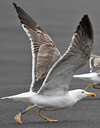 Lesser Black-backed Gull graellsii HRA.S 4CY & 8CY, May 2011 & May 2015, Belgium & the Netherlands. Picture: Peter Adriaens & Merijn Loeve.
Lesser Black-backed Gull graellsii HRA.S 4CY & 8CY, May 2011 & May 2015, Belgium & the Netherlands. Picture: Peter Adriaens & Merijn Loeve. Lesser Black-backed Gull graellsii BLB L-82711 4CY, May 29 2003, Voorhaven, Zeebrugge, Belgium (51.59N,04.02E).
Lesser Black-backed Gull graellsii BLB L-82711 4CY, May 29 2003, Voorhaven, Zeebrugge, Belgium (51.59N,04.02E). Lesser Black-backed Gull graellsii BLB L-89427 5CY, May 29 2003, Voorhaven, Zeebrugge, Belgium (51.59N,04.02E). No mirror on P10.
Lesser Black-backed Gull graellsii BLB L-89427 5CY, May 29 2003, Voorhaven, Zeebrugge, Belgium (51.59N,04.02E). No mirror on P10. Lesser Black-backed Gull graellsii BLB L-92064 4CY, May 29 2003, Voorhaven, Zeebrugge, Belgium (51.59N,04.02E).
Lesser Black-backed Gull graellsii BLB L-92064 4CY, May 29 2003, Voorhaven, Zeebrugge, Belgium (51.59N,04.02E). Lesser Black-backed Gull graellsii BLB L-92821 4CY, May 29 2003, Voorhaven, Zeebrugge, Belgium (51.59N,04.02E).
Lesser Black-backed Gull graellsii BLB L-92821 4CY, May 29 2003, Voorhaven, Zeebrugge, Belgium (51.59N,04.02E).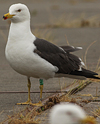 Lesser Black-backed Gull graellsii R6 4CY, May 04 2015, Rotterdam, the Netherlands. Picture: Merijn Loeve.
Lesser Black-backed Gull graellsii R6 4CY, May 04 2015, Rotterdam, the Netherlands. Picture: Merijn Loeve. Lesser Black-backed Gull graellsii 5.1 4CY, May 11 2016, Maasvlakte (Amazonehaven), the Netherlands (51.56 N 04.03 E).
Lesser Black-backed Gull graellsii 5.1 4CY, May 11 2016, Maasvlakte (Amazonehaven), the Netherlands (51.56 N 04.03 E). Lesser Black-backed Gull graellsii 5.S 4CY, May 11 2016, Maasvlakte (Amazonehaven), the Netherlands (51.56 N 04.03 E).
Lesser Black-backed Gull graellsii 5.S 4CY, May 11 2016, Maasvlakte (Amazonehaven), the Netherlands (51.56 N 04.03 E). Lesser Black-backed Gull graellsii N.8 4CY, May 30 - June
12 2016, Utrecht, the Netherlands.
Lesser Black-backed Gull graellsii N.8 4CY, May 30 - June
12 2016, Utrecht, the Netherlands. 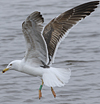 Lesser Black-backed Gull graellsii K.BJL 2CY & 4CY, January 2015 & May 2017, Quarteira, Portugal & Texel, the Netherlands.
Lesser Black-backed Gull graellsii K.BJL 2CY & 4CY, January 2015 & May 2017, Quarteira, Portugal & Texel, the Netherlands. mei 2014 - geringd in 2010 te IJmuiden 01.jpg) Lesser Black-backed Gull graellsii Y.ANL 5CY, May 13 2014, Sassenplaat, the Netherlands. Picture: Merijn Loeve.
Lesser Black-backed Gull graellsii Y.ANL 5CY, May 13 2014, Sassenplaat, the Netherlands. Picture: Merijn Loeve. Lesser Black-backed Gull graellsii PP4 5CY, May 12 2001, Dintelhaven
Maasvlakte, the Netherlands. Ringed at the nest at Maasvlakte June 28
1997.
Lesser Black-backed Gull graellsii PP4 5CY, May 12 2001, Dintelhaven
Maasvlakte, the Netherlands. Ringed at the nest at Maasvlakte June 28
1997.  Lesser Black-backed Gull graellsii EX07 5CY, May 12 2001, Dintelhaven
Maasvlakte, the Netherlands. Ringed at the nest at Maasvlakte June 21
1997.
Lesser Black-backed Gull graellsii EX07 5CY, May 12 2001, Dintelhaven
Maasvlakte, the Netherlands. Ringed at the nest at Maasvlakte June 21
1997. Lesser Black-backed Gull graellsii E558 5CY, May 12 2001, Dintelhaven
Maasvlakte, the Netherlands. Ringed at the nest at Maasvlakte June 15
1997.
Lesser Black-backed Gull graellsii E558 5CY, May 12 2001, Dintelhaven
Maasvlakte, the Netherlands. Ringed at the nest at Maasvlakte June 15
1997. Lesser Black-backed Gull graellsii EY84 5CY, May 12 2001, Dintelhaven
Maasvlakte, the Netherlands. Ringed at the nest at Maasvlakte June 24
1997.
Lesser Black-backed Gull graellsii EY84 5CY, May 12 2001, Dintelhaven
Maasvlakte, the Netherlands. Ringed at the nest at Maasvlakte June 24
1997.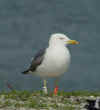 Lesser Black-backed Gull graellsii E056 E 4CY, May 13 2002, Missouriweg, Maasvlakte, the Netherlands (51.59N, 04.02E). A local 4cy bird.
Lesser Black-backed Gull graellsii E056 E 4CY, May 13 2002, Missouriweg, Maasvlakte, the Netherlands (51.59N, 04.02E). A local 4cy bird. Lesser Black-backed Gull graellsii E104 E 4CY, May 23 & 31 2002, EMO, Maasvlakte, the Netherlands (51.59N, 04.02E). A local 4cy bird.
Lesser Black-backed Gull graellsii E104 E 4CY, May 23 & 31 2002, EMO, Maasvlakte, the Netherlands (51.59N, 04.02E). A local 4cy bird. Lesser Black-backed Gull graellsii E119 E 4CY, May 12 2002, Naaktstrand, Maasvlakte, the Netherlands (51.59N, 04.02E). A local 4cy bird.
Lesser Black-backed Gull graellsii E119 E 4CY, May 12 2002, Naaktstrand, Maasvlakte, the Netherlands (51.59N, 04.02E). A local 4cy bird. Lesser Black-backed Gull graellsii E227 E 5CY, May 16 2004, Dintelhaven, Maasvlakte, the Netherlands (51.59N, 04.02E).
Lesser Black-backed Gull graellsii E227 E 5CY, May 16 2004, Dintelhaven, Maasvlakte, the Netherlands (51.59N, 04.02E). Lesser Black-backed Gull graellsii SA8 5CY, May 13 2002, Dintelhaven, Maasvlakte, the Netherlands (51.59N, 04.02E). Ringed at the Maasvlakte as pullus, June 20 1998.
Lesser Black-backed Gull graellsii SA8 5CY, May 13 2002, Dintelhaven, Maasvlakte, the Netherlands (51.59N, 04.02E). Ringed at the Maasvlakte as pullus, June 20 1998.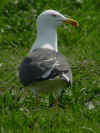 Lesser Black-backed Gull graellsii TT5 5CY, May 13 2002, Hartelhaven, Maasvlakte, the Netherlands (51.59N, 04.02E). Ringed at the Maasvlakte as pullus, July 08 1998.
Lesser Black-backed Gull graellsii TT5 5CY, May 13 2002, Hartelhaven, Maasvlakte, the Netherlands (51.59N, 04.02E). Ringed at the Maasvlakte as pullus, July 08 1998. Lesser Black-backed Gull graellsii NLA 5.464.730 4CY, May 23 2014, Vlaardingen, the Netherlands. Picture: Merijn Loeve.
Lesser Black-backed Gull graellsii NLA 5.464.730 4CY, May 23 2014, Vlaardingen, the Netherlands. Picture: Merijn Loeve.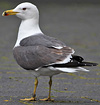 Lesser Black-backed Gull graellsii NLA 5.467.749 4CY, May 12 2014, Delft, the Netherlands. Picture: Merijn Loeve.
Lesser Black-backed Gull graellsii NLA 5.467.749 4CY, May 12 2014, Delft, the Netherlands. Picture: Merijn Loeve.Lesser Black-backed Gull: no black in the primary coverts.
We have illustrated all greater primary wing coverts of known-age Lesser Black-backed Gulls HERE.
.
 Lesser Black-backed Gull graellsii 0* 3CY & 4CY, June 2013 & May 2014, Noordwijk & Maasvlakte, the Netherlands. Picture: Merijn Loeve & Mars Muusse. Classic 3cy LBBG, complete moult started.
Lesser Black-backed Gull graellsii 0* 3CY & 4CY, June 2013 & May 2014, Noordwijk & Maasvlakte, the Netherlands. Picture: Merijn Loeve & Mars Muusse. Classic 3cy LBBG, complete moult started. Lesser Black-backed Gull graellsii 20 5cy male, May 06 2006. No black on primary coverts.
Lesser Black-backed Gull graellsii 20 5cy male, May 06 2006. No black on primary coverts. Lesser Black-backed Gull graellsii UA 6cy male, May 21 2005. No black on primary coverts.
Lesser Black-backed Gull graellsii UA 6cy male, May 21 2005. No black on primary coverts. Lesser Black-backed Gull graellsii P8 7cy male, May 21 2005. No black on primary coverts.
Lesser Black-backed Gull graellsii P8 7cy male, May 21 2005. No black on primary coverts. Lesser Black-backed Gull graellsii N05P 4CY, May 22 2014, Dordrecht, the Netherlands. Picture: Merijn Loeve.
Lesser Black-backed Gull graellsii N05P 4CY, May 22 2014, Dordrecht, the Netherlands. Picture: Merijn Loeve.Lesser Black-backed Gull: with black in the primary coverts.
We have illustrated all greater primary wing coverts of known-age Lesser Black-backed Gulls HERE.
.
 Lesser Black-backed Gull graellsii NY 4CY, May 30 2015, Vlissingen, the Netherlands. Picture: Merijn Loeve.
Lesser Black-backed Gull graellsii NY 4CY, May 30 2015, Vlissingen, the Netherlands. Picture: Merijn Loeve. Lesser Black-backed Gull graellsii 32 sub-adult, May 06 2006, Moerdijk breeding colony, the Netherlands. Black on primary coverts.
Lesser Black-backed Gull graellsii 32 sub-adult, May 06 2006, Moerdijk breeding colony, the Netherlands. Black on primary coverts. Lesser Black-backed Gull graellsii HV sub-adult, May 2005 & May 2014, Moerdijk & Sassenplaat, the Netherlands. Picture: Merijn Loeve & Mars Muusse.
Lesser Black-backed Gull graellsii HV sub-adult, May 2005 & May 2014, Moerdijk & Sassenplaat, the Netherlands. Picture: Merijn Loeve & Mars Muusse.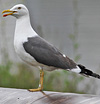 Lesser Black-backed Gull graellsii 1S 4CY & 12CY, May 2006 & May 2014, Moerdijk-Sassenplaat, the Netherlands. Picture: Merijn Loeve & Roland-Jan Buijs.
Lesser Black-backed Gull graellsii 1S 4CY & 12CY, May 2006 & May 2014, Moerdijk-Sassenplaat, the Netherlands. Picture: Merijn Loeve & Roland-Jan Buijs. Lesser Black-backed Gull graellsii BA 4CY & 12CY, May 2006 & March 2014, Moerdijk-Sassenplaat, the Netherlands. Picture: Merijn Loeve & Mars Muusse.
Lesser Black-backed Gull graellsii BA 4CY & 12CY, May 2006 & March 2014, Moerdijk-Sassenplaat, the Netherlands. Picture: Merijn Loeve & Mars Muusse. Lesser Black-backed Gull graellsii ET 12CY, 04 May 2006, Moerdijk breeding colony, the Netherlands. Black on primary coverts.
Lesser Black-backed Gull graellsii ET 12CY, 04 May 2006, Moerdijk breeding colony, the Netherlands. Black on primary coverts. Lesser Black-backed Gull graellsii J3 13CY, 16 May 2005, Moerdijk breeding colony, the Netherlands. Black on primary coverts.
Lesser Black-backed Gull graellsii J3 13CY, 16 May 2005, Moerdijk breeding colony, the Netherlands. Black on primary coverts..
LBBG with extensive black on the primary coverts: sub-adults.
We have illustrated all greater primary wing coverts of known-age birds HERE.
.
 Lesser Black-backed Gull graellsii 5X sub-adult, 08 May 2006, Moerdijk breeding colony, the Netherlands.
Lesser Black-backed Gull graellsii 5X sub-adult, 08 May 2006, Moerdijk breeding colony, the Netherlands. Lesser Black-backed Gull graellsii 7N sub-adult, 09 May 2006, Moerdijk breeding colony, the Netherlands.
Lesser Black-backed Gull graellsii 7N sub-adult, 09 May 2006, Moerdijk breeding colony, the Netherlands. Lesser Black-backed Gull graellsii 7X sub-adult, 09 May 2006, Moerdijk breeding colony, the Netherlands.
Lesser Black-backed Gull graellsii 7X sub-adult, 09 May 2006, Moerdijk breeding colony, the Netherlands. Lesser Black-backed Gull graellsii 40 sub-adult, 08 May 2006, Moerdijk breeding colony, the Netherlands.
Lesser Black-backed Gull graellsii 40 sub-adult, 08 May 2006, Moerdijk breeding colony, the Netherlands. Lesser Black-backed Gull graellsii CV sub-adult, 06 May 2006, Moerdijk breeding colony, the Netherlands.
Lesser Black-backed Gull graellsii CV sub-adult, 06 May 2006, Moerdijk breeding colony, the Netherlands. Lesser Black-backed Gull graellsii E0 sub-adult, 14 May 2006, Moerdijk breeding colony, the Netherlands.
Lesser Black-backed Gull graellsii E0 sub-adult, 14 May 2006, Moerdijk breeding colony, the Netherlands. Lesser Black-backed Gull graellsii HZ sub-adult, 14 May 2006, Moerdijk breeding colony, the Netherlands.
Lesser Black-backed Gull graellsii HZ sub-adult, 14 May 2006, Moerdijk breeding colony, the Netherlands. Lesser Black-backed Gull graellsii LE sub-adult, 16 May 2006, Moerdijk breeding colony, the Netherlands.
Lesser Black-backed Gull graellsii LE sub-adult, 16 May 2006, Moerdijk breeding colony, the Netherlands. Lesser Black-backed Gull graellsii S2 sub-adult, 21 May 2006, Moerdijk breeding colony, the Netherlands.
Lesser Black-backed Gull graellsii S2 sub-adult, 21 May 2006, Moerdijk breeding colony, the Netherlands. Lesser Black-backed Gull graellsii S9 sub-adult, 21 May 2006, Moerdijk breeding colony, the Netherlands.
Lesser Black-backed Gull graellsii S9 sub-adult, 21 May 2006, Moerdijk breeding colony, the Netherlands. Lesser Black-backed Gull graellsii 1S sub-adult, 16 May 2006, Moerdijk breeding colony, the Netherlands.
Lesser Black-backed Gull graellsii 1S sub-adult, 16 May 2006, Moerdijk breeding colony, the Netherlands. Lesser Black-backed Gull graellsii 1T sub-adult, 16 May 2006, Moerdijk breeding colony, the Netherlands.
Lesser Black-backed Gull graellsii 1T sub-adult, 16 May 2006, Moerdijk breeding colony, the Netherlands. Lesser Black-backed Gull graellsii A9 sub-adult, 02 May 2006, Moerdijk breeding colony, the Netherlands.
Lesser Black-backed Gull graellsii A9 sub-adult, 02 May 2006, Moerdijk breeding colony, the Netherlands. Lesser Black-backed Gull graellsii AY sub-adult, 02 May 2006, Moerdijk breeding colony, the Netherlands.
Lesser Black-backed Gull graellsii AY sub-adult, 02 May 2006, Moerdijk breeding colony, the Netherlands. Lesser Black-backed Gull graellsii K5 sub-adult, 05 May 2006, Moerdijk breeding colony, the Netherlands.
Lesser Black-backed Gull graellsii K5 sub-adult, 05 May 2006, Moerdijk breeding colony, the Netherlands. Lesser Black-backed Gull graellsii KZ sub-adult, 05 May 2006, Moerdijk breeding colony, the Netherlands.
Lesser Black-backed Gull graellsii KZ sub-adult, 05 May 2006, Moerdijk breeding colony, the Netherlands. Lesser Black-backed Gull graellsii LS sub-adult, 13 May 2006, Moerdijk breeding colony, the Netherlands.
Lesser Black-backed Gull graellsii LS sub-adult, 13 May 2006, Moerdijk breeding colony, the Netherlands. Lesser Black-backed Gull graellsii PK sub-adult, 16 May 2006, Moerdijk breeding colony, the Netherlands.
Lesser Black-backed Gull graellsii PK sub-adult, 16 May 2006, Moerdijk breeding colony, the Netherlands. Lesser Black-backed Gull graellsii PZ sub-adult, 16 May 2006, Moerdijk breeding colony, the Netherlands.
Lesser Black-backed Gull graellsii PZ sub-adult, 16 May 2006, Moerdijk breeding colony, the Netherlands. Lesser Black-backed Gull graellsii S6 sub-adult, 04 June 2006, Moerdijk breeding colony, the Netherlands.
Lesser Black-backed Gull graellsii S6 sub-adult, 04 June 2006, Moerdijk breeding colony, the Netherlands. Lesser Black-backed Gull graellsii SA sub-adult, 23 May 2006, Moerdijk breeding colony, the Netherlands.
Lesser Black-backed Gull graellsii SA sub-adult, 23 May 2006, Moerdijk breeding colony, the Netherlands. Lesser Black-backed Gull graellsii 73 sub-adult, 05 May 2005, Moerdijk breeding colony, the Netherlands.
Lesser Black-backed Gull graellsii 73 sub-adult, 05 May 2005, Moerdijk breeding colony, the Netherlands. esser Black-backed Gull intermedius sub-adult, Boulogne/Mer, NW
France,
May 17 2002.
esser Black-backed Gull intermedius sub-adult, Boulogne/Mer, NW
France,
May 17 2002.Growing P8.
 Lesser Black-backed Gull graellsii T7PF 4CY, Boulogne/Mer, NW
France,
May 01 2003.
Lesser Black-backed Gull graellsii T7PF 4CY, Boulogne/Mer, NW
France,
May 01 2003. Arrested moult at P6.
unringed LBBG sub-adults.
.
 Lesser Black-backed Gull sub-adult, May 08 2016, Nieuw-Haamstede, the Netherlands.
Lesser Black-backed Gull sub-adult, May 08 2016, Nieuw-Haamstede, the Netherlands.Graellsii-type.
 Lesser Black-backed Gull sub-adult, May 12 2013, Katwijk, the Netherlands.
Lesser Black-backed Gull sub-adult, May 12 2013, Katwijk, the Netherlands.Graellsii-type.
 Lesser Black-backed Gull sub-adult, May 19 2013, Katwijk, the Netherlands.
Lesser Black-backed Gull sub-adult, May 19 2013, Katwijk, the Netherlands.Graellsii-type.
 Lesser Black-backed Gull sub-adult, May 16 2013, Katwijk, the Netherlands.
Lesser Black-backed Gull sub-adult, May 16 2013, Katwijk, the Netherlands.Graellsii-type.
 Lesser Black-backed Gull sub-adult, May 10 2013, Katwijk, the Netherlands.
Lesser Black-backed Gull sub-adult, May 10 2013, Katwijk, the Netherlands.Graellsii-type.
 Lesser Black-backed Gull sub-adult, May 10 2013, Katwijk, the Netherlands.
Lesser Black-backed Gull sub-adult, May 10 2013, Katwijk, the Netherlands.Graellsii-type.
 Lesser Black-backed Gull sub-adult, May 19 2013, Katwijk, the Netherlands.
Lesser Black-backed Gull sub-adult, May 19 2013, Katwijk, the Netherlands.Graellsii-type.
 Lesser Black-backed Gull sub-adult, May 19 2013, Katwijk, the Netherlands.
Lesser Black-backed Gull sub-adult, May 19 2013, Katwijk, the Netherlands.Graellsii-type.
 Lesser Black-backed Gull sub-adult, May 12 2013, Katwijk, the Netherlands.
Lesser Black-backed Gull sub-adult, May 12 2013, Katwijk, the Netherlands.Graellsii-type.
 Lesser Black-backed Gull sub-adult, May 19 2013, Katwijk, the Netherlands. Intermedius-type.
Lesser Black-backed Gull sub-adult, May 19 2013, Katwijk, the Netherlands. Intermedius-type. Lesser Black-backed Gull sub-adult, May 19 2013, Katwijk, the Netherlands.
Lesser Black-backed Gull sub-adult, May 19 2013, Katwijk, the Netherlands.Graellsii-type.
 Lesser Black-backed Gull sub-adult, May 16 2013, Katwijk, theNetherlands.
Lesser Black-backed Gull sub-adult, May 16 2013, Katwijk, theNetherlands.Graellsii-type.
 Lesser Black-backed Gull sub-adult, May 19 2013, Katwijk, the Netherlands.
Lesser Black-backed Gull sub-adult, May 19 2013, Katwijk, the Netherlands.Graellsii-type.
 Lesser Black-backed Gull sub-adult, May 16 2013, Katwijk, the Netherlands.
Lesser Black-backed Gull sub-adult, May 16 2013, Katwijk, the Netherlands.Graellsii-type.
 Lesser Black-backed Gull sub-adult, May 10 2013, Katwijk, the Netherlands.
Lesser Black-backed Gull sub-adult, May 10 2013, Katwijk, the Netherlands.Graellsii-type.
 Lesser Black-backed Gull 4CY, May 28 2015, Leiden, the Netherlands.
Lesser Black-backed Gull 4CY, May 28 2015, Leiden, the Netherlands.Graellsii-type.
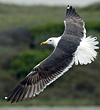 Lesser Black-backed Gull sub-adult, May 16 2013, Katwijk, the Netherlands.
Lesser Black-backed Gull sub-adult, May 16 2013, Katwijk, the Netherlands.Graellsii-type.
 Lesser Black-backed Gull sub-adult, May 16 2013, Katwijk, the Netherlands.
Lesser Black-backed Gull sub-adult, May 16 2013, Katwijk, the Netherlands.Graellsii-type.
 Lesser Black-backed Gull sub-adult, May 16 2013, Katwijk, the Netherlands.
Lesser Black-backed Gull sub-adult, May 16 2013, Katwijk, the Netherlands.Graellsii-type.
 Lesser Black-backed Gull sub-adult, May 16 2013, Katwijk, the Netherlands.
Lesser Black-backed Gull sub-adult, May 16 2013, Katwijk, the Netherlands.Graellsii-type.
 Lesser Black-backed Gull sub-adult, May 19 2013, Katwijk, the Netherlands.
Lesser Black-backed Gull sub-adult, May 19 2013, Katwijk, the Netherlands.Graellsii-type.
 Lesser Black-backed Gull sub-adult, May 16 2013, Katwijk, the Netherlands.
Lesser Black-backed Gull sub-adult, May 16 2013, Katwijk, the Netherlands.Graellsii-type.
 Lesser Black-backed Gull 4CY, May 28 2015, Leiden, the Netherlands.
Lesser Black-backed Gull 4CY, May 28 2015, Leiden, the Netherlands.Graellsii-type.
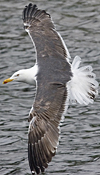 Lesser Black-backed Gull 4CY, May 28 2015, Leiden, the Netherlands.
Lesser Black-backed Gull 4CY, May 28 2015, Leiden, the Netherlands.Graellsii-type.
 Lesser Black-backed Gull 4CY, May 28 2015, Leiden, the Netherlands.
Lesser Black-backed Gull 4CY, May 28 2015, Leiden, the Netherlands.Graellsii-type.
Graellsii-type.
 Lesser Black-backed Gull 4CY, May 28 2015, Leiden, the Netherlands.
Lesser Black-backed Gull 4CY, May 28 2015, Leiden, the Netherlands.Graellsii-type.
 Lesser Black-backed Gull 4CY, May 24 2016, Katwijk, the Netherlands.
Lesser Black-backed Gull 4CY, May 24 2016, Katwijk, the Netherlands.Graellsii-type.
 Lesser Black-backed Gull 4CY, May 24 2016, Katwijk, the Netherlands.
Lesser Black-backed Gull 4CY, May 24 2016, Katwijk, the Netherlands.Graellsii-type.
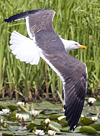 Lesser Black-backed Gull sub-adult, May 28 2015, Leiden, the Netherlands.
Lesser Black-backed Gull sub-adult, May 28 2015, Leiden, the Netherlands.Graellsii-type.
 Lesser Black-backed Gull 4CY, May 28 2015, Leiden, the Netherlands.
Lesser Black-backed Gull 4CY, May 28 2015, Leiden, the Netherlands.Graellsii-type.
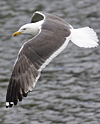 Lesser Black-backed Gull sub-adult, May 28 2015, Leiden, the Netherlands.
Lesser Black-backed Gull sub-adult, May 28 2015, Leiden, the Netherlands.Graellsii-type.
 Lesser Black-backed Gull 4CY, May 28 2015, Leiden, the Netherlands.
Lesser Black-backed Gull 4CY, May 28 2015, Leiden, the Netherlands.Graellsii-type.
 Lesser Black-backed Gull sub-adult, May 28 2015, Leiden, the Netherlands.
Lesser Black-backed Gull sub-adult, May 28 2015, Leiden, the Netherlands.Graellsii-type.
 Lesser Black-backed Gull 4CY, May 28 2015, Leiden, the Netherlands.
Lesser Black-backed Gull 4CY, May 28 2015, Leiden, the Netherlands.Graellsii-type.
 Lesser Black-backed Gull 4CY, May 28 2015, Leiden, the Netherlands.
Lesser Black-backed Gull 4CY, May 28 2015, Leiden, the Netherlands.Graellsii-type.
 Lesser Black-backed Gull sub-adult, May 28 2015, Leiden, the Netherlands.
Lesser Black-backed Gull sub-adult, May 28 2015, Leiden, the Netherlands.Graellsii-type.
 Lesser Black-backed Gull sub-adult, May 12 2013, Katwijk, the Netherlands.
Lesser Black-backed Gull sub-adult, May 12 2013, Katwijk, the Netherlands.Graellsii-type.



